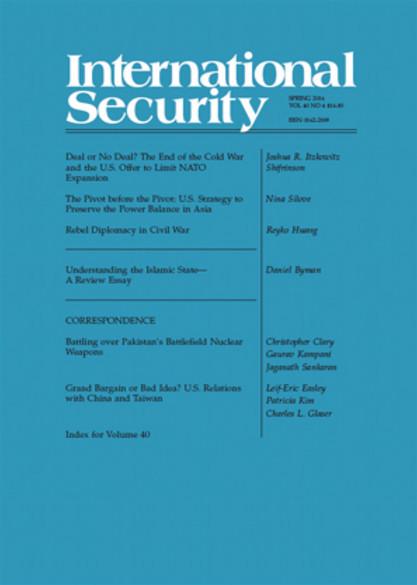通信:秘密能力和技术扩散风险
IF 4.8
1区 社会学
Q1 INTERNATIONAL RELATIONS
引用次数: 0
摘要
Brendan Green和Austin Long对和平时期秘密军事能力信号的理论框架做出了重大贡献在研究了冷战期间美国的反潜战(ASW)后,他们认为披露能力的选择取决于独特性(可替代性)和预期的对抗措施(第59-60页)。然而,格林和朗不能完全解释许多历史案例,因为他们忽视了决策者对技术传播的担忧。一个将他们的理论与对技术扩散的担忧结合起来的修正框架,通过解释在战争与和平时期揭示军事创新的更广泛的困境,提供了更大的预测能力。各国隐瞒军事能力是为了避免两种威胁:消灭和复制Green和Long的独特性变量和对策侧重于前者,而未能解决后者。格林和朗认为,如果反制措施的风险很低,或者存在替代能力,那么信号对于“改进一般威慑、转移对手资源、外交让步或战略调整”就变得有吸引力(第56页)。复制是一个完全不同的问题。披露信息可能会为对手提供洞察力,以提高他们自己的能力。格林和朗所确定的对无效的恐惧并不排除对技术扩散的担忧(第51-52页)。通信:秘密能力本文章由计算机程序翻译,如有差异,请以英文原文为准。
Correspondence: Clandestine Capabilities and Technological Diffusion Risks
Brendan Green and Austin Long make a signiacant contribution with their theoretical framework for peacetime signaling of clandestine military capabilities.1 Examining U.S. anti-submarine warfare (ASW) during the Cold War, they argue that choices to disclose capabilities depend on uniqueness (replaceability) and anticipated countermeasures (pp. 59–60). Green and Long cannot fully account for many historical cases, however, because they overlook decisionmaker concerns about the spread of technology. A modiaed framework combining their theory with fears of technological diffusion offers greater predictive power by explaining the broader dilemma of revealing military innovations during both war and peace. States conceal military capabilities to avoid two threats: nulliacation and duplication.2 Green and Long’s variables of uniqueness and countermeasures focus on the former while failing to address the latter. Green and Long argue that if the risk of countermeasures is low or if replacement capabilities exist, signaling becomes attractive for “improved general deterrence, adversary resource diversion, and diplomatic concessions or strategic adjustments” (p. 56). Duplication is a fundamentally different concern. Disclosures may provide an adversary with insights to improve their own capabilities. The fear of nulliacation identiaed by Green and Long does not preclude concerns about technological diffusion (pp. 51–52). Correspondence: Clandestine Capabilities
求助全文
通过发布文献求助,成功后即可免费获取论文全文。
去求助
来源期刊

International Security
Social Sciences-Law
CiteScore
7.40
自引率
10.00%
发文量
13
期刊介绍:
International Security publishes lucid, well-documented essays on the full range of contemporary security issues. Its articles address traditional topics of war and peace, as well as more recent dimensions of security, including environmental, demographic, and humanitarian issues, transnational networks, and emerging technologies.
International Security has defined the debate on US national security policy and set the agenda for scholarship on international security affairs for more than forty years. The journal values scholarship that challenges the conventional wisdom, examines policy, engages theory, illuminates history, and discovers new trends.
Readers of IS discover new developments in:
The causes and prevention of war
U.S.-China relations
Great power politics
Ethnic conflict and intra-state war
Terrorism and insurgency
Regional security in Africa, Asia, Europe, and Latin America
U.S. foreign and defense policy
International relations theory
Diplomatic and military history
Cybersecurity and defense technology
Political economy, business, and security
Nuclear proliferation.
 求助内容:
求助内容: 应助结果提醒方式:
应助结果提醒方式:


